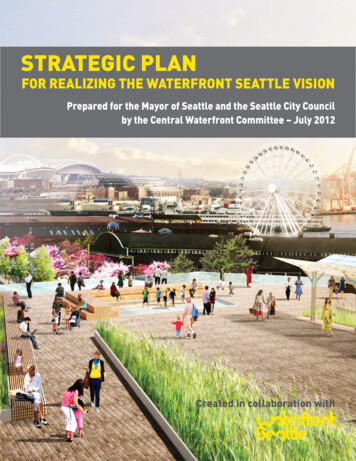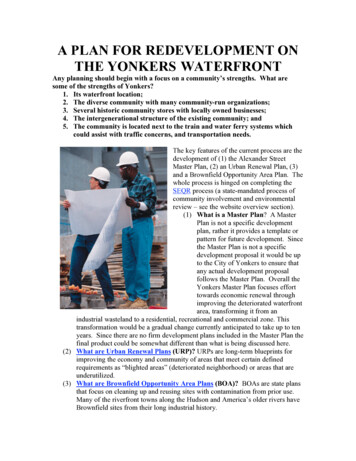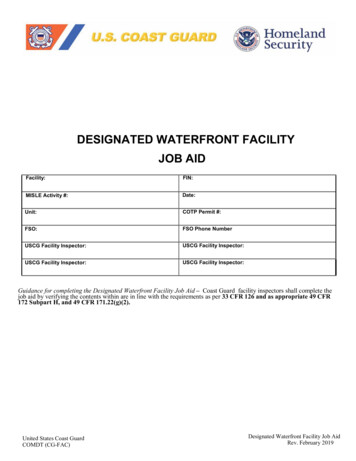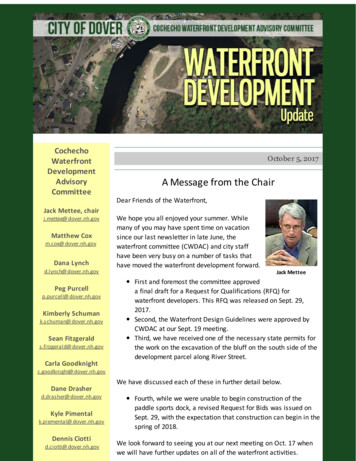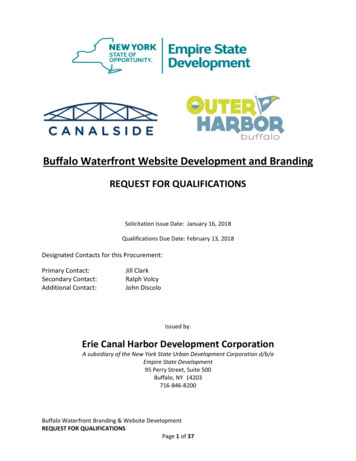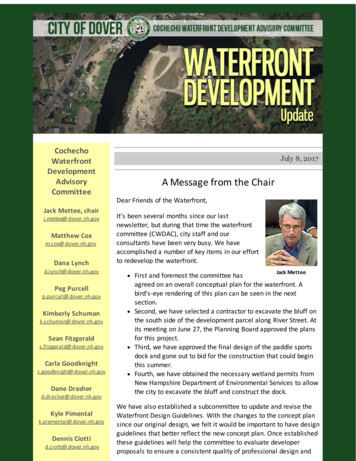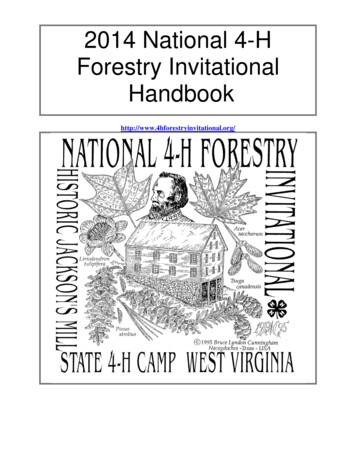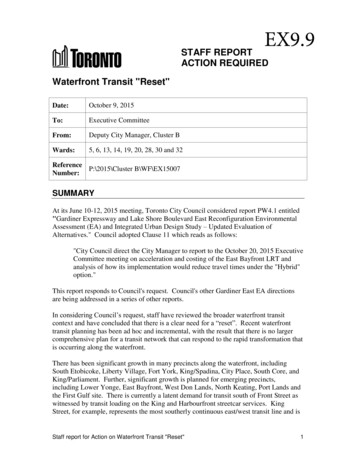
Transcription
EX9.9STAFF REPORTACTION REQUIREDWaterfront Transit "Reset"Date:October 9, 2015To:Executive CommitteeFrom:Deputy City Manager, Cluster BWards:5, 6, 13, 14, 19, 20, 28, 30 and 32ReferenceP:\2015\Cluster B\WF\EX15007Number:SUMMARYAt its June 10-12, 2015 meeting, Toronto City Council considered report PW4.1 entitled"Gardiner Expressway and Lake Shore Boulevard East Reconfiguration EnvironmentalAssessment (EA) and Integrated Urban Design Study – Updated Evaluation ofAlternatives." Council adopted Clause 11 which reads as follows:"City Council direct the City Manager to report to the October 20, 2015 ExecutiveCommittee meeting on acceleration and costing of the East Bayfront LRT andanalysis of how its implementation would reduce travel times under the "Hybrid"option."This report responds to Council's request. Council's other Gardiner East EA directionsare being addressed in a series of other reports.In considering Council’s request, staff have reviewed the broader waterfront transitcontext and have concluded that there is a clear need for a “reset”. Recent waterfronttransit planning has been ad hoc and incremental, with the result that there is no largercomprehensive plan for a transit network that can respond to the rapid transformation thatis occurring along the waterfront.There has been significant growth in many precincts along the waterfront, includingSouth Etobicoke, Liberty Village, Fort York, King/Spadina, City Place, South Core, andKing/Parliament. Further, significant growth is planned for emerging precincts,including Lower Yonge, East Bayfront, West Don Lands, North Keating, Port Lands andthe First Gulf site. There is currently a latent demand for transit south of Front Street aswitnessed by transit loading on the King and Harbourfront streetcar services. KingStreet, for example, represents the most southerly continuous east/west transit line and isStaff report for Action on Waterfront Transit "Reset"1
regularly experiencing near or at-capacity conditions through much of the weekday peakperiods. The extent of latent and anticipated future demand creates an imperative fordefining a long-term transit solution as soon as possible.Against this backdrop, numerous individual waterfront transit projects that would connectto the existing 509 Harbourfront LRT exist in different stages of approval: some EAs arein progress (Port Lands, Lower Yonge); some EAs have been approved but notimplemented (East Bayfront); and some EAs were started but never completed(Waterfront West). A map of proposed waterfront transit projects appears in Appendix 2.As a consequence of not having a comprehensive transit network solution for thewaterfront, there has been little progress in securing funding for new transit infrastructurein the area. Small amounts of committed funding exist in the City's WaterfrontRevitalization Initiative capital budget and from Waterfront Toronto's projected landdevelopment revenues; however, no single waterfront transit project is close to beingfunded and implemented.Waterfront transit is largely absent from the robust program of transit infrastructureinvestment currently underway and, to date, it is not under active consideration for anyfunding that may be available through existing Provincial and Federal governmentfunding programs. This, in spite of the fact that both the Waterfront West and WaterfrontEast LRTs are ranked in the top five unfunded rapid transit proposals in the preliminaryanalysis undertaken by City Planning as part of the five-year review of Official Plantransportation policies (known as "Feeling Congested?").A comprehensive review of waterfront transit projects is needed immediately to articulatethe opportunities and options that exist, and to propose an approach to advance waterfronttransit. A preliminary Terms of Reference for this exercise, including a publicconsultation strategy, has been drafted and attached as Appendix 1. It is anticipated thatthe review would extend from the Long Branch GO Station in the west to WoodbineAvenue in the east, and south of the Queensway/Queen Street corridor to Lake Ontario.The work would lead to a plan for a continuous waterfront transit network with east/westconnectivity, as well as strong integrated north/south connections that would link the Cityto the waterfront. This network would be further integrated with regional transit networkcomponents, including the GO and subway systems, Smart Track and connections toScarborough.The proposed review of waterfront transit initiatives and options would be undertaken bya consultant reporting to a team of staff from the City, TTC and Waterfront Toronto. Toensure expediency and maximum project oversight, it is recommended that the project bemanaged by an interagency Executive Steering Committee, similar to the Port LandsAcceleration Initiative. By Q2 of 2016, staff would provide a progress report toExecutive Committee on corridor options, preliminary costs, approvals and fundingopportunities. This would be followed by a final report to Executive Committee by theend of Q3 outlining study recommendations and next steps. The reset would becoordinated with the pending "Feeling Congested?" Official Plan transportation reviewStaff report for Action on Waterfront Transit "Reset"2
currently being undertaken by City Planning. Funds (up to 500,000) are available toconduct the reset in the Waterfront Revitalization Initiative capital budget.A reset on waterfront transit planning would be a first step towards a transit network thatcan respond to the rapid transformation that is occurring along Toronto’s waterfront. Itwould build on the momentum created by the three orders of government in supportingwaterfront revitalization. Further, it would prioritize projects that could be implementedin a phased manner through “Waterfront 2.0”, and funded through development chargesand Provincial/Federal funding programs.The other reporting matter requested by Council in the June 2015 direction and addressedin this staff report concerns the potential of an East Bayfront LRT to reduce travel timesunder the Gardiner East EA Hybrid option. The implementation of the East BayfrontLRT, and a number of other transit improvements, were already assumed in the traveltime forecasts contained in staff's May 2015 Gardiner East EA report.RECOMMENDATIONSThe Deputy City Manager, Cluster B, recommends that:1. City Council direct City staff, working with the TTC and Waterfront Toronto, toundertake a comprehensive review of waterfront transit initiatives and options,and provide a status update to Executive Committee in Q2 of 2016; and2. City Council direct City staff to fund the waterfront transit reset from the amountallocated for East Bayfront Transit in the Waterfront Revitalization Initiativecapital project CWR003-10.Financial ImpactThe cost of retaining consulting services to assist the City, the TTC and WaterfrontToronto in this exercise is estimated to be up to 500,000. Funding is available from theWaterfront Revitalization Initiative capital project CWR003-10.The Deputy City Manager and Chief Financial Officer has reviewed this report and agreeswith the financial impact information.DECISION HISTORYThe following Council decision links deal with the importance of transit to accommodategrowth in Toronto's waterfront:Central Waterfront Secondary Plan ouncil/cc030414/plt5rpt/cl001.pdfStaff report for Action on Waterfront Transit "Reset"3
East Bayfront Precinct Plan and Class Environmental Assessment Master Plan ouncil/cc051205/pof10rpt/cl002.pdfEast Bayfront Business and Implementation Plan ouncil/cc060725/pof6rpt/cl009.pdfWaterfront West Light Rail Transit (LRT) Environmental Assessment (2007)http://www.ttc.ca/About the TTC/Commission reports and information/Commissionmeetings/2007/Mar 21 2007/Other/Toronto Transit City.pdfMetrolinx Regional Transportation Plan "The Big Move" Lake Shore West – introductionof rapid transit along Lake Shore Road from Union Station to Port Credit /bigmove/big move.aspxEast Bayfront Transit Environmental Assessment: Streetcar Service on Queens Quay EastBetween Yonge Street and Parliament Street ecisions/2009-09-30-cc40-dd.htmEast Bayfront LRT story.do?item 2012.PG16.18Five-Year Official Plan Review – "Feeling Congested?" y?vgnextoid 3649837c1b915410VgnVCM10000071d60f89RCRDThe following link connects to the Council direction requesting this report: GardinerExpressway and Lake Shore Boulevard East Reconfiguration Environmental Assessment(EA) and Integrated Urban Design Study – Updated Evaluation of Alternatives story.do?item 2015.PW4.1The following link connects to the Council decision on the Waterfront Strategic ItemHistory.do?item 2015.EX7.6The following link connects to a Council Member's Motion requesting transit serviceimprovements in the western waterfront: The Shoreline: Request for the City of Torontoand the Toronto Transit Commission to provide improved transit for the City of Toronto'swestern waterfront – by Councillor Mark Grimes, seconded by Councillor Josh temHistory.do?item 2015.MM9.23Staff report for Action on Waterfront Transit "Reset"4
ISSUE BACKGROUNDThe attached study area map (Appendix 2) is a compilation of existing and proposedWaterfront LRT routes as understood today. A TTC streetcar map is also attached asAppendix 3. The existing 509 Harbourfront LRT serves Queens Quay West toExhibition Place, with connections to Spadina Avenue and Bathurst Street. Westwardexpansion of the LRT network has been proposed to run west from Union Station alongBremner Boulevard, through Exhibition Place, to Park Lawn Road and South Etobicoke.Eastward expansion of the LRT network would serve the emerging Lower Yonge andEast Bayfront neighbourhoods as part of a first phase; later phases would see the lineextended to the Port Lands, the First Gulf site and the Leslie Barns. The rationalizationof all these plans forms part of the work program in the proposed review.Planning for a robust transit network which connects people and places to the renewedwaterfront is a key tenet of the Central Waterfront Secondary Plan adopted by TorontoCity Council in 2003. One of the "Big Moves" in the Plan is a new waterfront transitnetwork, "an extended Waterfront LRT across the Central Waterfront from ExhibitionPlace to the Port Lands with excellent connections to the city". The plan calls for earlyimplementation of higher order transit before journey-to-work patterns are established, inorder to encourage transit-oriented travel patterns of residents and employees from theoutset. Expanded GO Transit rail services and an upgraded Union Station are alsoreferenced as critical elements of the new waterfront transit network.Significant growth pressures in the western waterfront, in areas such as Humber BayShores and Mimico, have highlighted the need for higher order transit west of ExhibitionPlace. In 2006, at the direction of Toronto City Council, the TTC initiated anEnvironmental Assessment (EA) for a proposed 11 kilometre Waterfront West LRT fromUnion Station through Exhibition Place to the Long Branch GO Station. Ultimately, theEA was never completed. Thus, the need for higher order transit enhancements in thewestern waterfront is unresolved.In the eastern waterfront, higher order transit is needed to facilitate the redevelopment ofLower Yonge, East Bayfront, North Keating, the Port Lands and the future office nodeplanned for the First Gulf site; it would also connect to the Leslie Barns. Higher ordertransit is key to achieving the aggressive employment targets planned for mixed-usecommunities in the waterfront. East Bayfront, for example, has a minimum target of25% employment-generating development for the precinct. Similarly, a split betweenresidential and employment uses is being assumed in the planning for the Port Lands.The vision for the First Gulf site is that of a secondary hub for office and relatedcommercial uses, which will rely on higher order transit for its success.As noted in the above Summary, the approach to dealing with existing demand andplanned growth to date has been ad hoc and incremental. The proposed waterfront transitreset is intended to provide an urgent response to address this deficiency by producing acomprehensive integrated network plan. This will facilitate decision-making regardingphasing opportunities, acceleration options and funding.Staff report for Action on Waterfront Transit "Reset"5
COMMENTSGrowth Demand in the WaterfrontSince the approval of the Central Waterfront Secondary Plan in 2003, the areas inproximity to Toronto's waterfront from South Etobicoke to the West Don Lands haveundergone significant transformation. New growth and revitalization is puttingimmediate pressure on the transit network. King Street, for example, represents the mostsoutherly continuous east/west transit line and is regularly experiencing near or atcapacity conditions through much of the weekday peak periods. South of King Street, ascan be seen in Appendix 3, there is no continuous east/west transit servicenotwithstanding the levels of development and associated activity occurring in this area.This imbalance is only expected to increase given the significant growth expected inemerging precincts, including Exhibition Place/Ontario Place, Lower Yonge, EastBayfront, North Keating, Port Lands and the First Gulf site. The extent of latent andanticipated future travel demand creates an imperative for defining a transit solution assoon as possible.Waterfront Transit FundingNotwithstanding the fact that both the Waterfront West and Waterfront East LRTs areranked in the top five unfunded rapid transit proposals in the preliminary analysis ofFeeling Congested?", there has been little funding allocated for waterfront transitprojects. The City's Waterfront Revitalization Initiative capital budget is carrying a smallallocation for East Bayfront Transit ( 12 Million) and Waterfront Toronto is committedto funding a portion of transit costs through future revenues. In addition, the Provincemade a 200 Million funding commitment to the East Bayfront LRT in 2014, in relationto the sale of the LCBO lands along Queens Quay. Even with these potential sources, thegap in funding for waterfront transit remains substantial.Coupled with the need to define a comprehensive waterfront transit solution is the need toexplore and tap into other potential funding sources. In July 2015, City Councilexpressed its strong interest in continuing the tri-government waterfront revitalizationpartnership. The City, through the Mayor, will be taking a leadership role by issuing aCall to Action to Provincial and Federal leaders – a time-limited, formal and structuredintergovernmental negotiation process to confirm Waterfront 2.0 funding commitments.Council confirmed four Waterfront 2.0 priorities: flood protection, waterfront transit,land servicing and public realm. A fresh look at waterfront transit opportunities andoptions, will allow the Mayor and City officials to more precisely articulate Citypriorities for transit funding through the waterfront revitalization partnership and throughProvincial and Federal funding programs. Results from the comprehensive review ofwaterfront transit projects can also be incorporated into the City's development chargesframework, the most rational way to fund municipal growth-related infrastructure.Staff report for Action on Waterfront Transit "Reset"6
Time for a Fresh Look at Waterfront TransitA comprehensive review of waterfront transit initiatives and options is needed to explorethe opportunities and options that exist to advance waterfront transit, within the contextof the Central Waterfront Secondary Plan, as well as changes that have occurred since itsadoption in 2003. The Smart Track and Relief Line initiatives are being evaluated by theCity and TTC in close collaboration with Metrolinx. Metrolinx is also undertaking theRegional Express Rail initiative in consultation with the City/TTC and other partners, toconsider significant upgrades to service on all the GO Transit corridors in the region.Options for additional GO Transit Stations throughout the network are also beingevaluated as part of the initiative. New projects, such as the proposed First Gulfredevelopment, have also emerged. Similarly, there is a renewed interest by the City andProvince in revitalizing Exhibition Place and Ontario Place. These changes are inaddition to the population and employment growth that continues to occur along thewaterfront.Furthering the above-noted imperatives to take action on defining a waterfront transitnetwork solution is the recent Members Motion by Councillor Grimes (Ward 6) at theSeptember 30 - October 1, 2015 City Council meeting (MM9.23), recommending that:"City Council request the City Manager and the Chief Executive Officer, TorontoTransit Commission to report back in November 2015 to the Toronto TransitCommission with a status update on:a) Relocating the current TTC Humber Loop to Park Lawn Road and Lake ShoreBoulevard West, such report to contain cost projections and timelines forrelocation; andb) "Closing the Gap" on a dedicated right-of-way from St. Joseph Hospital toExhibition Place and connecting options."Also related to this motion, was item EY9.33 that was considered and adopted byEtobicoke York Community Council on October 6, 2015, recommending that CityCouncil request the City Clerk to forward a copy of a letter from Councillors MarkGrimes (Ward 6) and Justin Di Ciano (Ward 5) to Metrolinx, citing the urgency of, andsupport for, a new GO Station at Park Lawn Road. This station is currently under reviewas part of Metrolinx's "New Station Analysis" report.Item a) from MM9.23 regarding the TTC Humber Loop extension and Item EY9.33regarding the Park Lawn GO Station would both be included in the scope of work for theupcoming Park Lawn/Lake Shore Transportation Master Plan study. The remaining ItemMM9.23 b) regarding "Closing the Gap" would be included in the scope of workidentified in Appendix 1.All of this work will be closely coordinated and integrated as appropriate into theWaterfront Transit Reset described herein.Staff report for Action on Waterfront Transit "Reset"7
Comprehensive Review of Waterfront Transit Projects – Work ProgramA preliminary Terms of Reference for the Waterfront Transit Reset including a publicconsultation component appears in Appendix 1. The proposed review would extend fromthe Long Branch GO Station in the west to Woodbine Avenue in the east, and south ofthe Queensway/Queen Street corridor to Lake Ontario.The transit reset for the Waterfront LRT would address and update a number of factors asthey apply to the study area. The first priority would be to consider waterfront transit inthe context of local and regional transit initiatives. Key among these is the role thattransit along the waterfront can play in serving the access needs of the six millionresidents of the Toronto region, of which 2.6 million are within the City. Toronto'swaterfront is a unique regional asset and must be made accessible by a network of qualitytransit services, ideally linking to a main east-west distributor spine. This network wouldneed to be integrated with regional transit components, including the GO and subwaysystems, Smart Track and connections to Scarborough.Once this overall context has been established and refined, an update of the ridershippotential of a new waterfront transit line, using the City's new transit model, would beundertaken. The ridership projections would be linked to land use growth, anticipatedpotential to facilitate revitalization projects, and assumptions regarding connections to thelarger transit network. These factors would all be considered as part of an initial networkassessment. Other remaining components of the work would include preliminary costing,priority phasing for implementation, and next steps in the decision-making and approvalsprocess.Staff are proposing to retain a consulting team that would report to a staff team from theCity, TTC and Waterfront Toronto. To ensure expediency and maximum projectoversight, it is recommended that the project be managed by an interagency ExecutiveSteering Committee, similar to the Port Lands Acceleration Initiative. By Q2 of nextyear, a progress report would be provided to Executive Committee on the way forwardincluding details on a funding strategy and the necessary approvals process. This wouldbe followed by a final report in Q3 outlining recommendations emanating from theassessment and public engagement, and next steps necessary to deliver a phased programof needed waterfront transit improvements. The reset would be coordinated with thepending "Feeling Congested?" Official Plan transportation review.The work program for this study will have oversight by staff of Waterfront Toronto.However, the staff of the Transportation Planning Section, City Planning, will beresponsible for managing the consultant to deliver the transit plan and related detailsoutlined in this report, including technical analysis as required. Budget Committeerecently requested the Chief Planner and Executive Director to report on this unit's workprogram and ability to undertake new work, including waterfront transit planning. In thecontext of this report, the need for new staff positions to respond to waterfront transitpriorities is required.Staff report for Action on Waterfront Transit "Reset"8
Implementation of East Bayfront Transit and the "Hybrid" OptionThe other reporting matter requested by Council in the June 2015 direction and addressedthrough this staff report concerns the potential of an East Bayfront LRT to reduce traveltimes under the Gardiner East EA Hybrid option. The implementation of the EastBayfront LRT, and a number of other transit improvements, were already assumed in thetravel time forecasts contained in staff's May 2015 Gardiner East EA report.The transit improvements assumed in the transportation modelling work for the GardinerEA are critical to realizing the land use vision for the waterfront, and were considered aspart of the future base conditions before any options for the road network were assessed.Based on an understanding of work already completed, and assuming that land usegrowth projections are valid, removing the East Bayfront LRT from the modelassumptions would be expected to negatively impact local traffic and transit conditions inthe Central Waterfront and the Port Lands, and create a disconnect in the continuoustransit service.As part of the reset, the 1.6-kilometre East Bayfront LRT will be studied further. Thepreferred alternative arising from the 2010 East Bayfront Transit EA, provides for a newpassenger platform at 45 Bay Street (across from the Air Canada Centre) and extensivenew tunneling below Bay and Queens Quay. These items represent over 50% of the 520Million project budget ( 2016) and approximately 80% of the capital cost relatingdirectly to constructing transit. The remaining costs are for rolling stock andreconstruction of Queens Quay.The breakdown of the 520 Million East Bayfront LRT is as follows:New eastbound passenger platform: 112 MillionExtension of Bay Street tunnel to Freeland Street: 156 MillionSurface infrastructure: 66 MillionRolling stock: 36 MillionQueens Quay revitalization: 150 MillionAs part of the reset, staff would explore options to reduce East Bayfront transit projectcosts and/or develop East Bayfront transit incrementally. A review of options to ensurethe project is not delayed indefinitely is warranted.Staff report for Action on Waterfront Transit "Reset"9
ConclusionA reset on waterfront transit planning would be a first step towards a transit network thatcan respond to the rapid transformation that is planned and presently occurring alongToronto’s larger waterfront. It would build on the momentum created by the three ordersof government in revitalizing Toronto's waterfront. Further, it would prioritize projectsthat could be implemented in a phased manner through “Waterfront 2.0”, and fundedthrough development charges and Provincial/Federal funding programs.CONTACTSDavid Stonehouse, DirectorWaterfront Secretariatdstoneh@toronto.ca416 392-8113Tim Laspa, DirectorTransportation Planningtlaspa@toronto.ca416-392-8100Hilary Holden, DirectorTransit & Sustainable UREJohn W. Livey, F.C.I.PDeputy City Manager, Cluster BATTACHMENTSAppendix 1: Comprehensive Review of Waterfront Transit Network, Preliminary Termsof ReferenceAppendix 2: Study Area MapsAppendix 3: TTC Streetcar MapStaff report for Action on Waterfront Transit "Reset"10
Appendix 1Comprehensive Review of Waterfront Transit NetworkPreliminary Terms of ReferenceThe following Preliminary Terms of Reference is based on the background informationand history regarding waterfront transit service, and more importantly, the need toconsider a comprehensive and continuous connected solution to realize growth andaccommodate travel in a sustainable manner.1. Study DesignThe study area for the comprehensive review will address the area from Lake ShoreBoulevard at Long Branch in the west, Woodbine Ave and Queen Street in the east, andgenerally south of the Queensway/Queen Street. The study area will be reviewed andrefined as necessary at the Study Design stage.The study design will also describe the issues and the opportunities for transit to bestserve the long-term vision and revitalization of Toronto's waterfront. The key issue is thelack of a continuous waterfront transit service, and some of the specific concerns arecrowding on the King streetcar line and the increasing demand for transit service fromcompleted development projects. Opportunities that would be created by a new lineinclude fulfilling a key City objective for a comprehensive "transit first" solution toaccommodating future growth, and the opportunity to support revitalization options forExhibition Place, Ontario Place, the Port Lands and other key sites along the waterfront.2. Review of Background MaterialWaterfront revitalization and transit planning in the City has a long history, and allrelevant information and documents will be made available. The information deals withprevious route selection and assessment, relevant approvals secured, and estimated costs.The consulting team will be required to review and become familiar with this material.3. Update Baseline ConditionsExisting conditions in the study area, including land use growth, travel behavior patterns,and road and transit improvements will all be updated to reflect current conditions. Thisis a key step before considering the future conditions, and the exercise must also capturethe significant amount of change that is currently underway.4. Local and Regional Transit PlansTransit in the City and region has been the subject of a great deal of planning andforecasting in recent years. A key task will be to establish the latest planningassumptions from the TTC, Metrolinx and the City as they pertain to the waterfront. ThisStaff report for Action on Waterfront Transit "Reset"11
would include TTC service improvements, Metrolinx Regional Express Rail, UnionStation and Scarborough transit connections, as well as the City's latest work on SmartTrack and the Relief Line, as well as the "Feeling Congested?" update to the OfficialPlan.5. Land Use Growth and Transportation TrendsThe transportation modelling analysis for the future considers land use and transportationassumptions for the Greater Toronto Area, but a more detailed assessment of the studyarea will be required. This assessment will consider input from City staff regardingsignificant new development projects, as well as any currently anticipated changes to thetransportation network.6. Transit Modelling Sensitivity Test of the Waterfront LRTThe City's transportation model will be used to assess the large scale implications of thefuture condition with and without a Waterfront LRT line. The consulting team will berequired to conduct a more detailed study area analysis using an appropriatetransportation modelling assessment tool that captures the transit planning sensitivities inthe project study area. This work will help to confirm the initial problem andopportunities evaluation task.7. Identify Transit Routes for EvaluationThe selection of transit route alternatives will first consider a strategic overview, and willthen focus down to the confirmation of transit technology based on problem/opportunityassessment, background information, transit modelling for future base conditions, policydirection, cost, ridership potential, and other relevant factors. The study will consider upto six route options or variations on portions of individual routes. Potential routes forconsideration would include Lake Shore Boulevard, the Queensway, Rail/GardinerCorridor, redevelopment lands (e.g., Exhibition Place and Ontario Place), FortYork/Bremner Boulevard, Front Street, Queens Quay, Commissioners Street, as well asnorth-south connections. The options will be considered in the context of a networksolution that best meets the project objectives in the context of the City's Official Planpolicies.8. Develop Evaluation CriteriaThe successful Proponent shall develop a comprehensive set of evaluation criteria for theassessment of alternative route solutions. The criteria will reflect City, TTC, WaterfrontToronto and Metrolinx polici
Staff report for Action on Waterfront Transit "Reset" 3 currently being undertaken by City Planning. Funds (up to 500,000) are available to conduct the reset in the Waterfront Revitalization Initiative capital budget. A reset on waterfront transit planning would be a first step towards a transit network that


